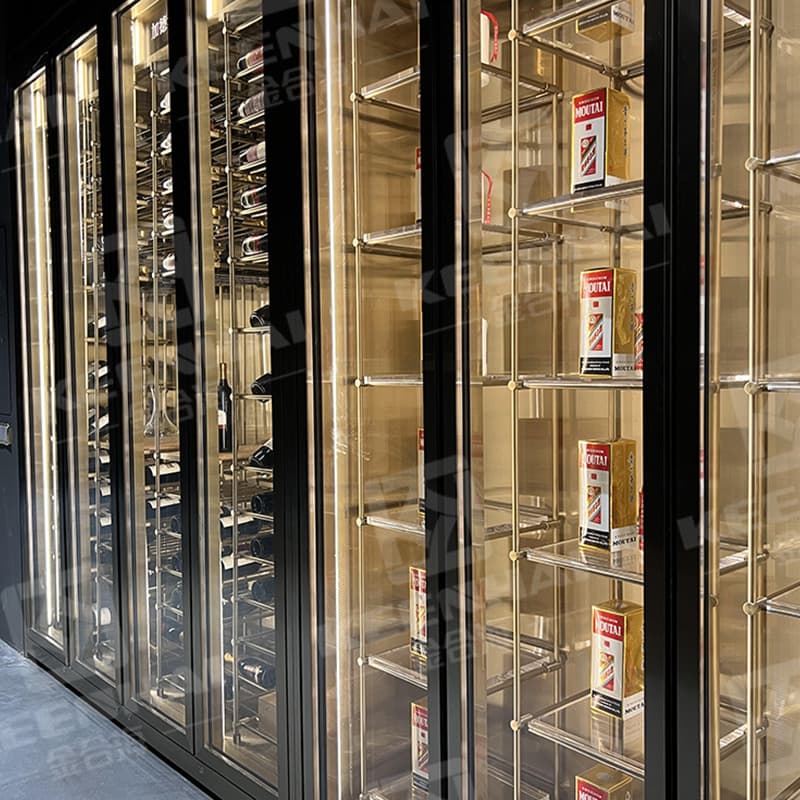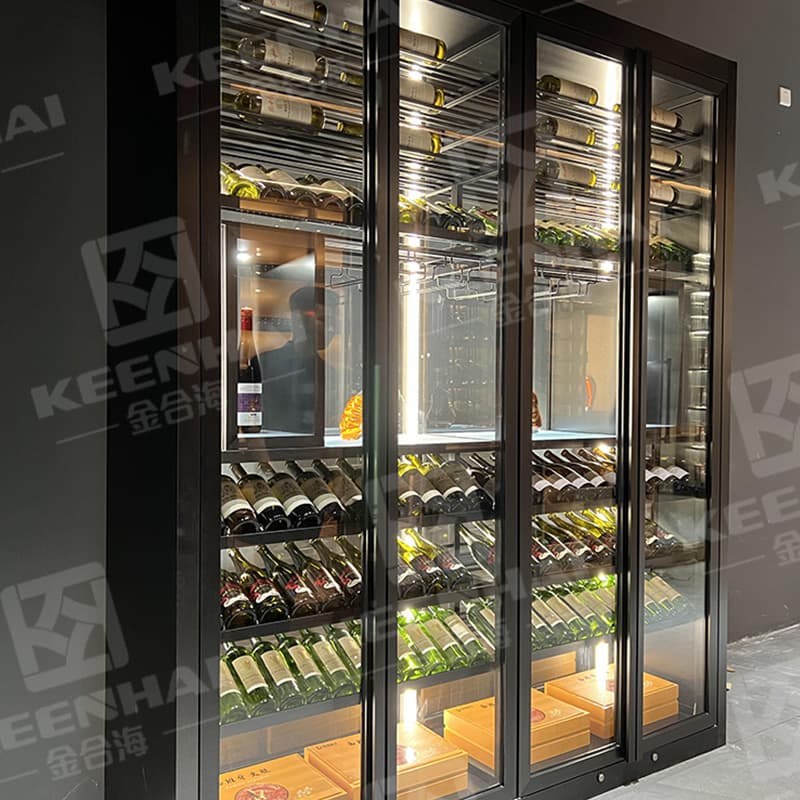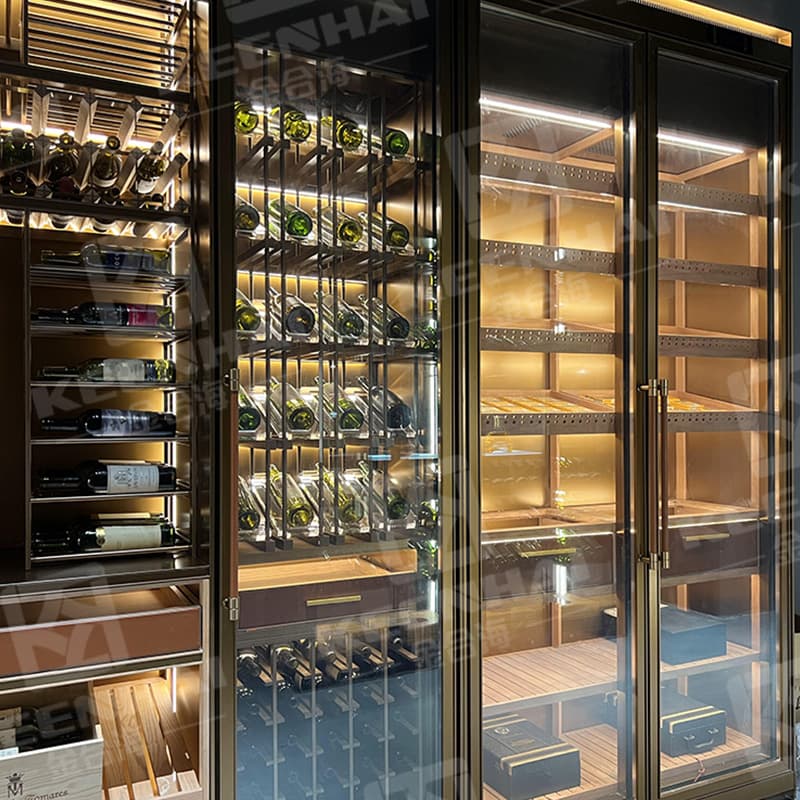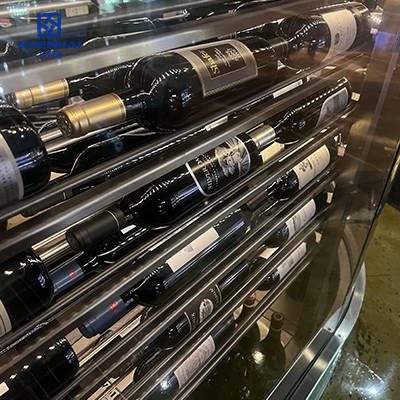When comparing longevity, stainless steel wine cabinets clearly outperform wood in every measurable factor: moisture resistance, load capacity, and scratch durability. Real-world examples show steel units remain functional and visually appealing for decades, while wood often requires refinishing or replacement every 5–10 years. Investing in stainless steel reduces maintenance costs and ensures your wine collection stays securely stored in optimal conditions.
1. Material Durability Comparison
1.1 Corrosion and Moisture Resistance
When it comes to resisting corrosion and moisture, stainless steel wine cabinets clearly outperform wooden options. High-grade stainless steel, like SUS 304 and 316, keeps its structure intact even in humid environments, resisting rust and oxidation. For instance, a coastal apartment with frequent humidity spikes saw its stainless steel cabinets maintain flawless finish after several years, while nearby wooden cabinets started warping and showing mold spots. This makes stainless steel a reliable choice for kitchens, basements, or open-plan lofts where moisture is unavoidable.
Wood, on the other hand, naturally absorbs water, which gradually weakens joints and surfaces. Even treated hardwood can swell, split, or discolor, reducing its lifespan significantly compared to steel alternatives.
1.2 Impact of Temperature and Humidity
Fluctuations in temperature and humidity can dramatically affect cabinet longevity. Stainless steel wine cellars handle these variations effortlessly. They maintain shape and structural integrity even when temperatures swing between 55°F and 75°F, a common range in wine storage rooms. Wood, however, reacts by expanding and contracting, which gradually loosens joints and weakens surfaces.
Here’s a practical comparison of performance under environmental stress:
| Särdrag | Stainless Steel Wine Cabinets | Wooden Cabinets |
|---|---|---|
| Moisture Resistance | Excellent, resists rust and warping | Moderate to poor, absorbs water |
| Temperature Fluctuation | Stable, minimal deformation | Prone to cracking and joint loosening |
| Lifespan in Humid Conditions | 20+ years | 5–10 years depending on treatment |
| Maintenance Needs | Low, easy to clean | High, requires polishing and sealing |
For example, designers often install stainless steel wine racks inside loft kitchens or commercial tasting rooms, ensuring bottles remain perfectly supported without warping or sagging, even under fluctuating conditions.
1.3 Resistance to Scratches and Dents
In high-traffic kitchens or wine bars, cabinets face daily wear from bottles, glassware, and occasional bumps. Stainless steel bar cabinets resist scratches and dents far better than wood. Even solid wood surfaces with protective finishes show marks quickly, while steel maintains a clean, polished look with minimal upkeep.
Practical steps to extend durability:
-
Place protective mats or liners under heavy bottles.
-
Lift bottles instead of dragging them across the surface.
-
Regularly wipe stainless steel surfaces with a soft cloth and pH-neutral cleaner.
Using quality stainless steel wine cabinets or racks ensures your storage system stays functional and visually appealing for decades, even in busy kitchens or commercial environments.

2. Maintenance Requirements
2.1 Cleaning and Care for Stainless Steel Cabinets
Maintaining stainless steel wine cabinets is straightforward compared to wood. Daily upkeep requires only a soft microfiber cloth to remove fingerprints and minor dust. For stubborn stains, a pH-neutral cleaner or a mixture of mild soap and water works perfectly. Avoid abrasive pads or harsh chemicals—they can scratch the surface.
In commercial settings, stainless steel cabinets in wine bars often endure high traffic and frequent handling. Routine steps include:
-
Wipe spills immediately to prevent residue buildup.
-
Clean weekly with a damp cloth, followed by a dry wipe to maintain luster.
-
Inspect joints and hinges monthly to ensure stability and smooth operation.
Thanks to these simple steps, stainless steel cabinets maintain a like-new appearance for 20+ years, far exceeding the typical lifespan of wooden alternatives.
2.2 Cleaning and Care for Wooden Cabinets
Wood cabinets require a more nuanced approach. Oak, walnut, or mahogany absorb moisture and react to temperature changes, so cleaning must balance protection and hydration. Daily wiping with a dry or slightly damp cloth is essential, and a monthly application of wood conditioner or oil prevents cracking and preserves color.
In humid environments, wood storage areas should be monitored for mold growth. For instance, in a high-end residential wine room, owners often use humidity meters and occasional anti-fungal wipes to maintain optimal conditions. Even with diligent care, wooden cabinets usually require refinishing or touch-ups every 3–5 years to maintain aesthetic quality and prevent surface degradation.
2.3 Long-Term Maintenance Costs
Over the long term, stainless steel cabinets are significantly more cost-effective than wood. While the initial investment may be higher, ongoing maintenance expenses are minimal—typically just cleaning supplies and occasional hinge lubrication.
For wood cabinets, total maintenance costs include:
-
Regular polishing and sealing treatments (2–4 times per year)
-
Repairs for dents, scratches, or warped panels
-
Replacement or refinishing after 5–10 years, depending on environmental conditions
In real-world scenarios, a commercial wine bar operating 12–14 hours daily found that wooden cabinetry required almost double the maintenance budget compared to stainless steel setups. This data demonstrates that investing in stainless steel not only saves money over time but also reduces labor and operational complexity.
3. Structural Integrity Over Time
3.1 Warping and Deformation Risks
One of the main challenges for wooden cabinets is warping over time, especially under fluctuating humidity or uneven weight distribution. Even well-treated hardwood can expand or contract seasonally, causing doors to misalign or panels to bow. In contrast, stainless steel cabinets—including stainless steel wine cabinets—retain their shape with minimal deformation, regardless of environmental changes.
For example, a high-end urban apartment with an open wine display experienced consistent weight from hundreds of bottles. Wooden racks began showing noticeable sag after two years, while stainless steel shelves maintained perfect alignment and support, proving long-term structural stability.
3.2 Joint and Fastener Durability
Durable construction relies on strong joints and hardware. Wooden cabinets typically use dowels, screws, and glue, which weaken over time due to natural wood movement. Seasonal expansion and contraction can loosen these connections, requiring regular tightening or reinforcement.
Stainless steel cabinets, however, use welded or reinforced metal joints and heavy-duty fasteners. Stainless steel bar cabinets in commercial bars demonstrate that even with daily handling, hinges, brackets, and welds show negligible wear after 10+ years. Maintenance usually involves only checking bolts and occasional hinge lubrication, a far simpler routine than wood.
3.3 Load-Bearing Capacity
Load-bearing capacity is critical for wine storage, especially for mixed bottle sizes or large-format bottles. Stainless steel shelves support significantly more weight without bending or sagging, while wooden shelves can deform under heavy loads.
Typical load comparison:
| Cabinet Type | Maximum Shelf Load | Notes |
|---|---|---|
| Stainless Steel Wine Cabinets | 120–150 lbs per shelf | Minimal sag over decades |
| Wooden Cabinets | 50–70 lbs per shelf | Risk of bowing and joint stress |
For practical application, commercial wine bars often prefer stainless steel wine racks inside cabinets because they can safely hold hundreds of bottles in a compact footprint. In residential wine rooms, homeowners appreciate that even large-format bottles and occasional stacking do not compromise stability, reducing the need for costly repairs or replacements.

4. Environmental Factors Affecting Longevity
4.1 Indoor vs Outdoor Placement
Cabinet placement dramatically affects longevity. Stainless steel cabinets maintain their durability indoors and in covered outdoor spaces, resisting moisture, dust, and occasional temperature swings. Outdoor wooden cabinets, however, degrade quickly under unprotected exposure, suffering from warping, cracking, and finish fading.
For instance, a rooftop wine terrace installed a stainless steel cabinet system to handle summer heat, occasional rain, and strong winds. After three years, the steel structure remained perfectly aligned, whereas nearby wooden units showed noticeable panel separation and discoloration. This illustrates why indoor or protected outdoor placement is essential for extending wood cabinet life, while stainless steel provides more flexibility.
4.2 Effects of Sunlight Exposure
Direct sunlight accelerates fading, drying, and cracking in wooden cabinets. UV rays break down the protective finishes, causing uneven coloring and surface brittleness over time. In contrast, stainless steel surfaces resist UV degradation entirely, maintaining consistent color and strength.
A practical scenario: in a sunlit wine room with large windows, a wooden cabinet lost its rich walnut tone in less than two years, while stainless steel wine cabinets retained a polished, uniform look. Regular rotation or shading helps wooden units, but steel remains low-maintenance.
4.3 Influence of Wine Storage Conditions
Temperature, humidity, and bottle weight all influence cabinet longevity. Stainless steel excels under fluctuating wine storage conditions, whether bottles are stored upright, on their sides, or in mixed-size configurations. Wooden shelves, however, are more susceptible to deformation when heavy bottles or stacked cases apply constant pressure.
Recommended environment for maximum lifespan:
-
Maintain ambient temperature between 55–65°F.
-
Keep relative humidity at 50–70%.
-
Avoid overloading shelves; follow manufacturer load ratings.
Stainless steel wine racks inside cabinets help distribute weight evenly, preventing localized stress and sagging, making them ideal for both residential and commercial applications. Over time, this translates to lower maintenance and reduced risk of structural damage, especially compared to wood.

5. Lifespan Estimates Based on Real-World Use
5.1 Average Lifespan of Stainless Steel Cabinets
High-quality stainless steel cabinets typically last 20–30 years under normal residential conditions. In commercial wine bars, daily handling and high humidity rarely reduce lifespan below 15–20 years if routine cleaning and minimal maintenance are performed. For example, a downtown wine bar using stainless steel wine cabinets saw zero structural issues after a decade of continuous use, despite heavy bottle rotation and varying bottle sizes. This longevity, combined with low upkeep, makes stainless steel the preferred material for both residential and professional applications.
5.2 Average Lifespan of Wooden Cabinets
Wooden cabinets, even when crafted from premium oak or walnut, usually last 5–10 years in typical conditions. Variations in humidity, exposure to sunlight, and heavy bottle loads accelerate wear. In real-world cases, residential wine enthusiasts notice surface scratches, warping, and fading within a few years, especially if bottles are stacked frequently or the room experiences seasonal temperature swings. Even periodic refinishing only temporarily restores appearance and structural integrity.
5.3 Factors That Can Extend or Reduce Lifespan
Several factors influence how long any cabinet lasts:
-
Material Quality – Higher-grade stainless steel or treated hardwood lasts longer.
-
Environmental Conditions – Humidity, temperature, and sunlight exposure significantly impact wood more than steel.
-
Maintenance – Regular cleaning, proper load distribution, and protective measures extend lifespan.
-
Usage Intensity – Frequent bottle movement or high traffic accelerates wear.
In practice, combining stainless steel wine cabinets with carefully designed wine racks, proper placement, and routine care maximizes longevity. For businesses or homeowners seeking reliable, long-term wine storage solutions, exploring our full range of stainless steel products at pvdstainlesssteel.com offers the most durable and maintenance-friendly options.






